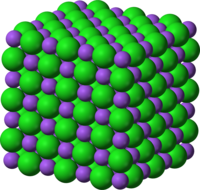
Photo from wikipedia
A convenient, reversible, fast, and wide-range switching of thermal conductivity is desired for efficient heat energy management. However, traditional methods, such as temperature-induced phase transition and chemical doping, have many… Click to show full abstract
A convenient, reversible, fast, and wide-range switching of thermal conductivity is desired for efficient heat energy management. However, traditional methods, such as temperature-induced phase transition and chemical doping, have many limitations, e.g., the lack of continuous tunability over a wide temperature range and low switching speed. In this work, a strategy of electric field-driven crystal symmetry engineering to efficiently modulate thermal conductivity is reported with first-principles calculations. By simply changing the direction of an external electric field loaded in ferroelectric PbZr0.5Ti0.5O3, near the morphotropic phase boundary composition, we obtain the largest switching of thermal conductivity for ferroelectric materials at room temperature based on the dual-phonon theory, i.e., normal and diffuson-like phonons, with three different criteria. The calculation results indicate that with decreasing crystal symmetry, the degeneracy of phonon modes reduces and the avoid-crossing behavior of phonon branches enhances, leading to the increase of diffuson-like phonons and weighted phonon-phonon scattering phase space. A thermal switch prototype based on PbZr0.5Ti0.5O3 is further shown that can protect the Li-ion battery by modulating its temperature up to 17.5 °C. Our studies would pave the way for designing next-generation thermal switch with high speed, a wide temperature range, and a large switching ratio.
Journal Title: ACS applied materials & interfaces
Year Published: 2022
Link to full text (if available)
Share on Social Media: Sign Up to like & get
recommendations!